While the #MeToo movement has prompted important discussions about workplace equality, a comprehensive
The research, conducted in February and March of 2018, reveals which industries have the highest prevalence of unwanted sexual conduct, blind spots that may be preventing corrections, and how millennials differ from other generations on possible solutions. The following are highlights of the study across professional communities, including banking, payments, mortgages, financial advisory, accounting, health care, employee benefits and capital markets (including municipal finance and M&A advising).
1) Wealth management is the worst industry for sexual harassment among all sectors studied
Financial advisory professionals are far more likely to say unwanted sexual conduct is highly prevalent in their industry than the average survey respondent. Many respondents cited their industry’s history and traditions as a factor. “It’s getting better, but it is a carry-over from years past when the industry included a substantial amount of flirting and hitting on, which today is more likely than not called sexual harassment,” says one male survey respondent, who has 25 years of industry experience.
Additional respondent comments:
- “While there have been some high profile lawsuits by women, the locker room attitude continues." (M, 55)
- There is a “relatively high ratio of males to females in all roles but especially in higher power roles.” (F, 55-59)
- “Although getting better, there were many cases of men abusing their power in the past couple of decades.” (F, 21-25)
- “Investment advisory is very male, lots of big egos. I see the worst behavior when I'm at a conference — the alcohol and being away from home seems to make some men regress back into 18-year-old frat boys.” (F, 60-64)

2) Smaller organizations are more vulnerable
Among respondents at organizations with fewer than 100 employees, 16% say harassment is highly prevalent in their industry. The responses suggest this is related to a lack of extensive human resources departments that would otherwise facilitate training and patrol transgressions. When companies have fewer than 100 employees “it is easy to be loose and less professional as there are no ramifications," says one respondent (M, 50-54).
Additional respondent comments:
- "At least for my company, we are too small and don't have a big name reputation at stake. We also don't have the resources or employees who are trained to handle these situations.” (F, 30-34)
- There’s "no training on the subject of sexual harassment." (M, 50-54)
- “A lot of firms are small without an effective HR mechanism to make a complaint.” (M, 50-54)
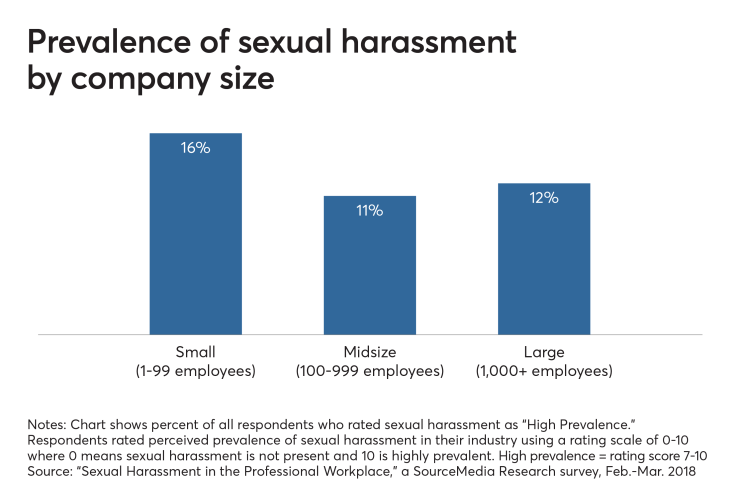
3) Men have high awareness of sexual harassment in their industries …
Women are more likely to have personally been subject to sexual harassment (31% of all female respondents), but men and women are equally aware that harassment is happening. Awareness is defined as having experienced, witnessed or heard about unwelcome sexual conduct.
Respondent comments:
- “It appears to have reached a groundswell such that most, if not all, industries are likely to finally take women seriously in the workplace. It's about time. I'm a white male, so I've no axe to grind.” (M, 50-54)
- "As an administrator I saw acts of sexual misconduct, comments made about female and male representatives. These acts came from all levels, from executives to independent agents." (F, 35-39)
- “Everyone is watching everyone; however, some people will still violate boundaries.” (M, 60-64)
- "Lack of law, culture that victim gets further pressure from gossip." (M, 35-39)
- “I will admit that during my time in the [banking] industry, a problem with sexual misconduct happened but it was addressed and the guilty person was terminated.” (M, 70-74)
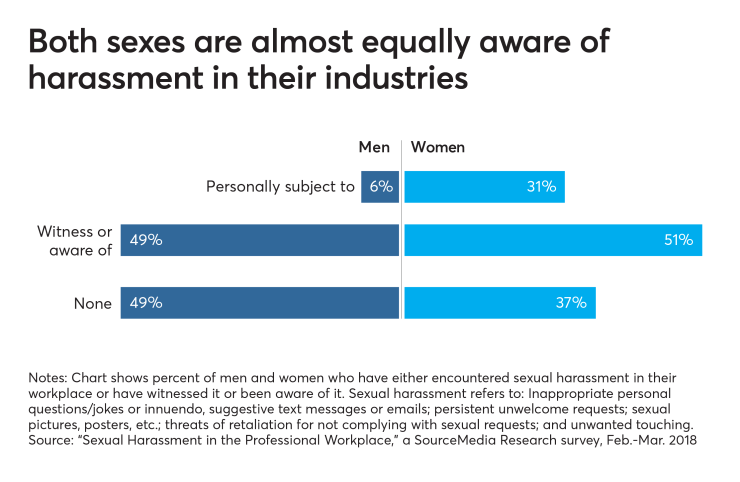
4) … But men have a blind spot
It seems woke men aren’t really that woke. There is a gap between what women who have experienced sexual harassment say is happening in the workplace and what men say is happening and to what extent. Men cite “inappropriate questions, jokes and innuendo” to the same degree as women. But men are far less aware of the extent of persistent unwelcome requests, threats of retaliation and unwanted touching — perhaps because these behaviors are deemed acceptable by some men or perhaps because these behaviors are less visible.
Respondent comments:
- “At the start of my profession as an auditor, I was sexually harassed by clients and my employer did nothing to deal with the issue.” (F, 60-64)
- “Even with education, it is sometimes not identified as sexual harassment.” (F, 55-59)
- “I think an appreciation and understanding of what is appropriate and inappropriate is a big part of the issue.” (M, 45-49)
- “Associates work together a lot. Sometimes very late and develop a rapport. Boundaries blur and sometimes lines are crossed. This field is male dominated too, so any ‘attractive’ woman may also receive more attention because of it.” (M, 21-25)
- “Employees think everyone accepts this behavior as ‘playing around’.” (F, 40-44)
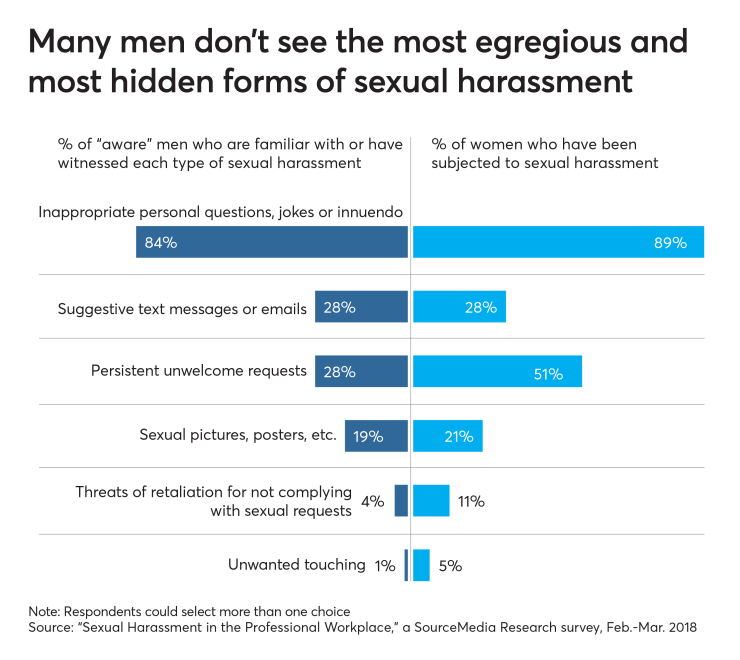
5) 6% of men say they have been the subject of sexual harassment; nearly half of them sit in the executive suite today
“Some people — male & female, just can't help themselves,” says one man (60-64). “I'm not certain if ‘unwelcome sexual conduct’ will ever be eliminated, but hopefully some people will be a little smarter about their actions.”
Additional respondent comments:
- “Constant invites to ‘work out’ together.” (M, 30-34)
- “Long hours, late nights, strong pressure to advance through complying with requests.” (M, 30-34)
- “Long hours and lots of stress. In the office most of the day, people tend to attract to one another.” (M, 21-25)
- “Desire for power [over] others.” (M, 40-44)
6) Apathy reigns when harassment is frequent, underreported and tolerated
When we focused on respondents who find themselves in the worst-case scenario — those who perceive high frequency of harassment, lack of reporting and lack of organizational responsiveness — we found a real sense of hopelessness, even bitterness.
These respondents have little faith that the problem of sexual harassment in the professional workplace will be solved. Unwanted sexual behavior is going unreported, these respondents say. They don’t believe their industries have prioritized fixing the issue. Some respondents understood the implications: “Our industry is a critical industry and one source of the nation’s wealth,” writes one female information technology professional (age 40-44). “They [must] prioritize this matter highly in order to sustain and keep competent employees.”
Additional respondent comments:
- “Little interest to upper management until someone gets caught.” (M, 35-39)
- “I think it's a priority when a complaint is filed, but lower ongoing priority than other business needs.” (F, 50-59)
- “Everyone is paying it lip service. The orgs where this is prevalent think they can continue to get away with it.” (M, 40-44)
- “There are so many competing priorities and other legislative burdens that have to be complied with that this is just one in a long list of items that have to be dealt with.” (F, 50-54)
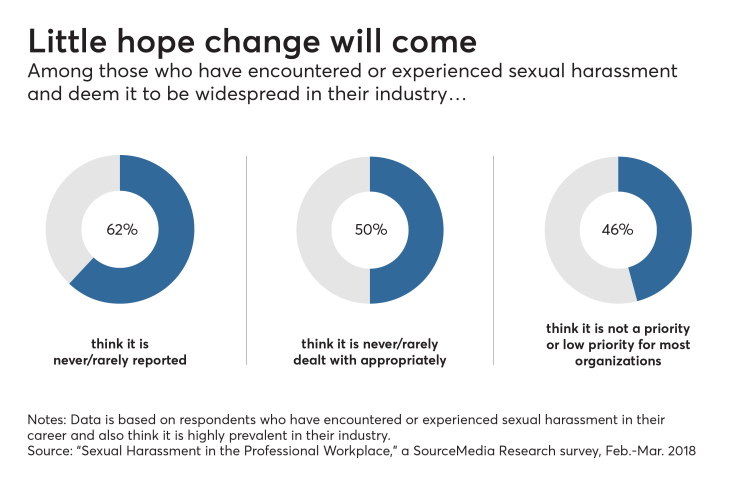
7) Executive women are more likely to believe their industry views harassment as a low priority than executive men
Executive women — almost a third of whom say they have experienced unwelcome sexual behavior — aren’t as confident that their industries are willing to address and solve the problem of workplace sexual harassment.
Compared with male executives, they are less likely to believe their industry has prioritized the issue. Even as executive women express frustration, they cite business needs: “Upper management has more pressing priorities,” says one women, a 20-year veteran in the consulting industry. “They are typically male and don't see the need for increased emphasis.”
Additional respondent comments:
- “It is a rare occurrence. Financial regulations are more of a concern, protection of the client.” (F, 55-59)
- “Industry will be slow to change if it costs money to do so. They will weigh the risk and the reward for changing their culture or process.” (F, 55-59)
- “Historically too few women in positions of upper management/C-suite level; male attitudes that such behavior is just ‘joking around’ or ‘banter’; fear that not going along with it is perceived as not being a team player.” (F, 40-44)
- “Addressing this issue presents an immediate cost with very little perceived benefit, at least initially.” (F, 40-44)
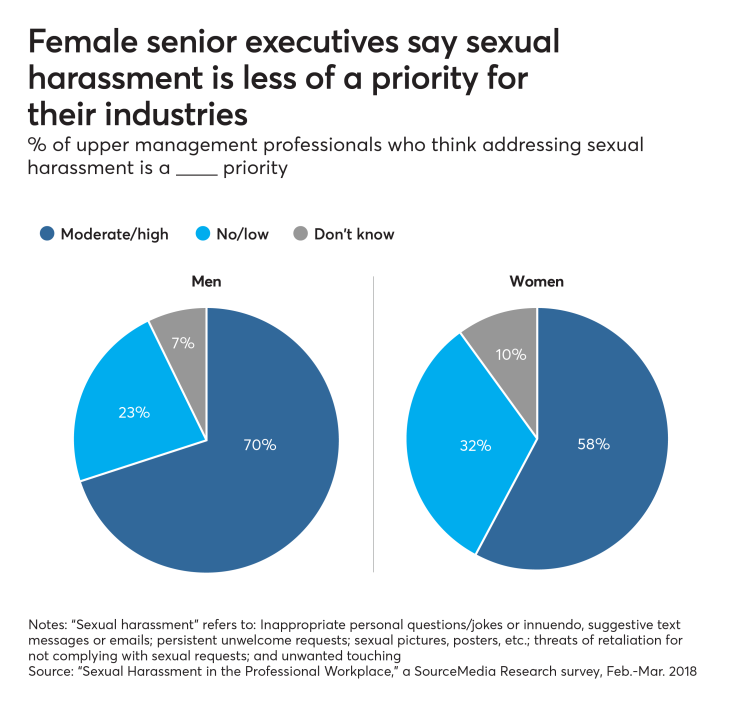
8) Young people have a different take on what solutions will work
While respondents overall rank government intervention low among possible solutions to the problem of harassment, the so-called millennial generation is more open to such measures than other generational age groups. Millennials, defined here as respondents aged 21-34, were also less likely to believe that workplace sensitivity training would be an effective solution. (Across all age groups, respondents put more faith in solutions within the company: workplace cultural changes, upper management commitment, and better HR procedures to handle complaints.)
Respondent comments:
- “Good talking point like diversity, innovation and other buzzwords. I am skeptical about the follow-up on these issues. (M, 26-29)
- “No one cares here. They only want to ‘appear’ to care.” (F, 30-34)
- “At the moment, I consider this issue as a ‘compliance’ regulation framework.” (M, 30-34)
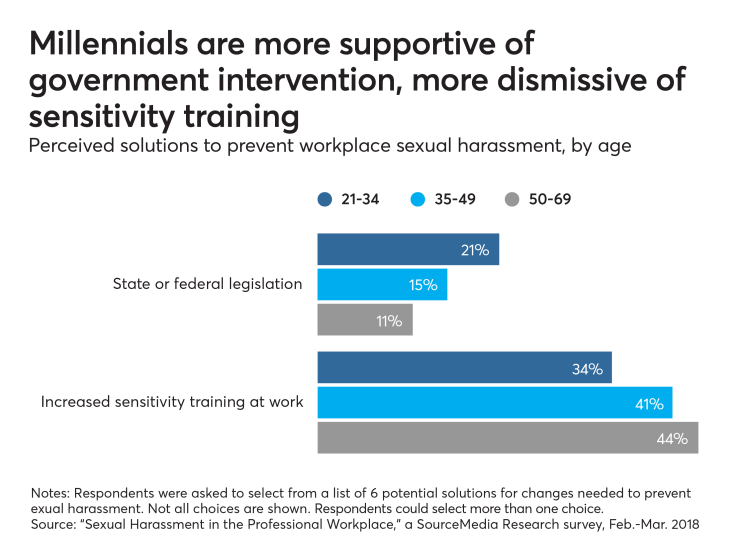
9) Women who experience the most severe forms of sexual harassment are doubtful reports will be handled fairly
Fewer than half of respondents say they think harassment is handled fairly by organizations in their industry. Women who have been subject to the most severe forms of unwelcome sexual behavior have the least confidence organizations in their industry will do the right thing.
Respondent comments:
- “Some residents and physicians feel they are superior and untouchable by management.” (F, 50-54)
- “In education there is a heightened awareness of this problem and the necessity of dealing with it swiftly and fairly.” (F, 50-54)
- “Because the banking industry’s leaders are generally asleep at the wheel. Taking action as we have done at our organization is not happening at peer banks.” (F, 50-54)
- “Financial services industry has never dealt with women in a real way. Unfortunately there are not enough women in upper mgmt to force change.” (F, 60-64)
- “Too many other mandatory job requirements on their plate to deal with other important issues.” (M, 65-69)
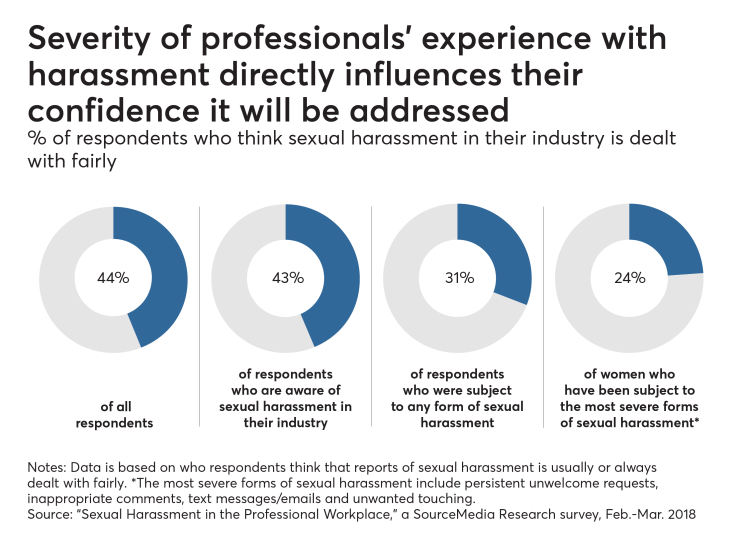
10) Message to a jaded society: Most professionals and business people see #MeToo as a positive force
A majority of respondents, regardless of age, rank or gender, believe the #MeToo movement will create at least some change in the professional workplace. To be sure, only 10% say it will have a high impact. But a strong belief that change is coming has clearly permeated the professional communities we surveyed.
Additional respondent comments:
- “The #MeToo movement has upper-level executives scared. They now realize the consequences for this unwanted behavior.” (F 50-59)
- “I would think the impact will always be both negative and positive. Positive in the sense that it will shed light on the issue but negative in a sense that people will look to take advantage of this movement at the expense of the people involved and overall cause.” (M, 35-39)
- “I believe journalistic attention to this situation has brought it higher in the mindset and thoughts of executives and HR personnel; but not high enough yet.” (F, 55-59)
- “Social media movements move the media, not so much the real world. Makes people feel good to self-actualize but has little impact on actual behaviors. Real people doing real things within the organization and among its client/customer base will have meaningful impact.” (M, 65-69)

Also in this series:





